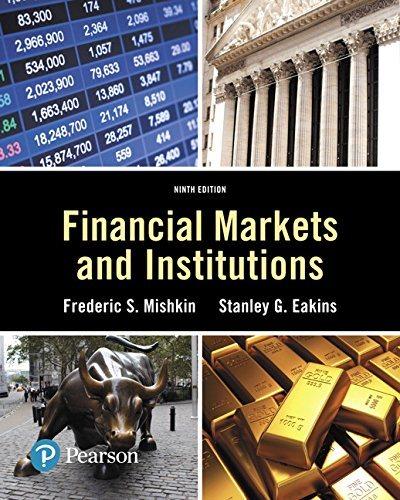Question
Part A i.When valuing European Vanilla Options in the Black-Scholes-Merton Model, there is one source of uncertainty. What is this uncertainty? ii.Why does a short
Part A
i.When valuing European Vanilla Options in the Black-Scholes-Merton Model, there is one source of uncertainty. What is this uncertainty?
ii.Why does a short call position in a European vanilla option typically have negative delta ()?
Part B
The current price of a non-dividend paying asset is $65, the riskless interest rate is 5% p.a. continuously compounded, and the option maturity is five years.
What is the lower boundary for the value of a European vanilla put option on this asset with strike price of $80?
Part C
Two companies have investments which pay the following rates of interest:
Fixed Float
Firm A 6% Libor
Firm B 8% Libor + 0.5%
Assume A prefers a fixed rate and B prefers a floating rate. If an intermediary charges both parties equally a 0.1% fee and any benefits are spread equally between Firm A and Firm B. If an intermediary charges both parties equally a 0.1% fee and any benefits are spread equally between Firm A and Firm B, what rates could A and B receive on their preferred interest rate?
 Part A i. When valuing European Vanilla Options in the BlackScholesMerton Model, there is one source of uncertainty. What is this uncertainty? ii. Why does a short call position in a European vanilla option typically have negative delta ()? Part B The current price of a nondividend paying asset is $65, the riskless interest rate is 5% p.a. continuously compounded, and the option maturity is five years. What is the lower boundary for the value of a European vanilla put option on this asset with strike price of $80? Part C Two companies have investments which pay the following rates of interest: Fixed Float Firm A 6% Libor Firm B 8% Libor + 0.5% Assume A prefers a fixed rate and B prefers a floating rate. If an intermediary charges both parties equally a 0.1% fee and any benefits are spread equally between Firm A and Firm B. If an intermediary charges both parties equally a 0.1% fee and any benefits are spread equally between Firm A and Firm B, what rates could A and B receive on their preferred interest rate
Part A i. When valuing European Vanilla Options in the BlackScholesMerton Model, there is one source of uncertainty. What is this uncertainty? ii. Why does a short call position in a European vanilla option typically have negative delta ()? Part B The current price of a nondividend paying asset is $65, the riskless interest rate is 5% p.a. continuously compounded, and the option maturity is five years. What is the lower boundary for the value of a European vanilla put option on this asset with strike price of $80? Part C Two companies have investments which pay the following rates of interest: Fixed Float Firm A 6% Libor Firm B 8% Libor + 0.5% Assume A prefers a fixed rate and B prefers a floating rate. If an intermediary charges both parties equally a 0.1% fee and any benefits are spread equally between Firm A and Firm B. If an intermediary charges both parties equally a 0.1% fee and any benefits are spread equally between Firm A and Firm B, what rates could A and B receive on their preferred interest rate Step by Step Solution
There are 3 Steps involved in it
Step: 1

Get Instant Access to Expert-Tailored Solutions
See step-by-step solutions with expert insights and AI powered tools for academic success
Step: 2

Step: 3

Ace Your Homework with AI
Get the answers you need in no time with our AI-driven, step-by-step assistance
Get Started


